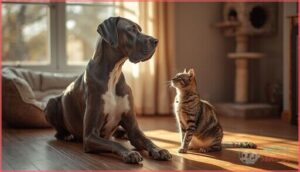This site is supported by our readers. We may earn a commission, at no cost to you, if you purchase through links.
You’ve probably seen those viral videos—a towering Great Dane curled up with a tiny tabby cat, both snoozing peacefully. It looks idyllic, but you’re wondering if that’s the exception or the norm.
The truth is, most Great Danes possess a gentle temperament that makes them surprisingly compatible with cats, though success isn’t automatic. Research shows that 40-60% of cats display stress behavior when first meeting large dogs, which means your feline might need time to adjust to a dog that could weigh ten times their size.
The good news? With proper introductions and an understanding of both species’ behavioral cues, you can create a household where your gentle giant and your cat don’t just tolerate each other—they thrive together.
Table Of Contents
Key Takeaways
- Great Danes typically get along with cats due to their gentle temperament, with 86% of owners reporting peaceful coexistence when introductions are handled carefully over a 2-6 week adjustment period.
- Early socialization between 3-14 weeks is critical—puppies exposed to positive cat interactions during this window show 70% higher tolerance to feline behaviors and 40% fewer chasing tendencies as adults.
- Success depends more on individual temperament and proper environmental setup than breed alone, requiring vertical escape routes for cats, separate feeding areas, and supervised interactions with consistent training.
- Most cats initially show stress (40-60% exhibit avoidance or defensive behaviors), but 70% adapt positively over time when given safe spaces and gradual exposure to the dog.
Do Great Danes Get Along With Cats?
The short answer is yes—Great Danes can get along with cats, but it depends on several factors. Their gentle temperament often works in their favor, but their sheer size can be intimidating for feline housemates.
Let’s look at what influences this relationship and what you can realistically expect.
Typical Great Dane Temperament
Great Danes earn their “gentle giants” reputation through their affectionate nature and calm demeanor. Despite standing 30-32 inches tall and weighing up to 175 pounds, these dogs display considerable emotional sensitivity and patience.
They’re people-oriented companions who crave closeness with their families, often showing “lapdog” tendencies regardless of size. Their protective instincts manifest as watchfulness rather than aggression, making their gentle temperament ideal for multi-pet households. Early socialization can help them become well-adjusted adults.
Cat Reactions to Large Dogs
While Great Danes may be gentle, cats don’t always see it that way. Studies show 40-60% of cats exhibit stress behavior when first meeting large dogs. You’ll notice avoidance tactics like hiding, elevated heart rates in 60% of cats, and defensive postures.
Common physiological indicators include:
- Piloerection (fur standing up) in 25% of encounters
- Increased vocalization by 40%
- Pupillary dilation in 55% of cats
Understanding these feline behavior signals helps you recognize cat stress early.
Real-Life Compatibility Experiences
Beyond those initial stress signals, most Great Dane and cat relationships actually work out well. Around 86% of owners report peaceful coexistence when introductions are handled carefully. The adjustment periods generally last 2 to 6 weeks, with 55% of pairings developing mutual tolerance or even friendship.
Most Great Dane and cat relationships succeed, with 86% achieving peaceful coexistence within 2 to 6 weeks when introduced properly
| Compatibility Factor | Percentage | Outcome |
|---|---|---|
| Peaceful coexistence | 86% | Successful integration |
| Low prey drive shown | 72% | Reduced chasing behavior |
| Mutual tolerance developed | 55% | Friendly interactions emerge |
| Socialization failures | 40% | Primary cause of incompatibility |
| Stress reduction over time | 70% | Cats adapt positively |
Great Danes and cats compatibility often improves dramatically after those first few weeks, especially when you invest in proper introductions and ongoing socialization.
Factors Affecting Great Dane and Cat Relationships
Whether your Great Dane and cat become best friends or just polite housemates depends on several key factors. Some of these you can control through careful planning, while others relate to the individual animals themselves.
Let’s look at what influences how well these two very different pets will get along in your home.
The Role of Early Socialization
Socializing your Great Dane during the critical period between 3 and 14 weeks dramatically shapes how they’ll interact with cats throughout their life. Puppies exposed to positive interactions with cats during this window show 70% higher tolerance to feline behaviors and 40% fewer chasing tendencies later on.
These early socialization techniques create lasting behavioral outcomes, building the foundation for peaceful coexistence and delivering long-term benefits that persist into adulthood.
Impact of Pet Age and Personality
While puppies and kittens bond more easily—with 67% engaging in regular play—your adult pets bring different challenges. Age differences matter: older Great Danes show 45% less tolerance toward unfamiliar cats, while senior cats adapt better than younger ones.
Personality traits like your dog’s prey drive and your cat’s boldness dramatically affect pet compatibility.
Health factors in aging pets, including joint pain, can trigger irritability and require careful management to help behavioral changes support harmony.
Importance of Individual Temperament
Temperament matters more than breed alone when predicting Great Dane temperament and cat personality compatibility. Genetic influence shapes your dog’s baseline friendliness, but socialization effects and owner impact determine real-world success. Great Danes benefit from positive reinforcement training, which can help manage their interactions with cats.
Watch for these behavioral indicators of good pet compatibility:
- Your Great Dane shows patience without dominant behaviors
- Low reactivity during initial cat encounters
- Playful energy balanced with impulse control
- Calm responses to sudden cat movements
- Temperament stability across different situations and environments
Preparing Your Home for Both Pets
Before you bring your Great Dane and cat together, you’ll need to set up your home in a way that works for both of them. Think of it as creating a space where your cat feels secure and your dog has boundaries.
Here are three key areas to focus on as you prepare your home for a peaceful coexistence.
Creating Safe Spaces for Cats
Your cat needs vertical retreats and hidden sanctuaries where your Great Dane can’t follow. Set up elevated paths using cat trees, wall shelves, or tall furniture—cats with access to high spots show fewer stress behaviors in multi-pet homes.
Create safe zones by pulling furniture slightly from walls, forming cat-sized escape routes. These safe spots for cats aren’t optional; they’re essential for a safe environment for pets.
Using Gates and Barriers
Baby gates work like invisible walls—81% of veterinary behaviorists recommend them for initial introductions. Choose sturdy, tall barrier types your Great Dane can’t jump, and add visual barriers (blankets or poster boards) to block eye contact that triggers chasing.
Pet baby gates create safe spots for cats while allowing gradual exposure. This setup gives you safety supervision without full separation, and 74% of owners report successful containment with proper gate effectiveness.
Separate Feeding and Resting Areas
Food aggression drops sharply when you provide spatial separation—separate bowls in different rooms prevent competition. Your Great Dane needs her food bowl away from the cat’s safe space to reduce stress and support hygiene protocols.
Resting comfort matters too: cats prefer elevated spots while dogs need floor-level beds. This setup, paired with a petbaby gate, ensures stress reduction and peaceful coexistence in shared pet feeding areas.
Introducing a Great Dane to a Cat
Once your home is ready, the real work begins: bringing your Great Dane and cat face-to-face for the first time without turning it into a disaster. Start with scent swapping—let them smell each other’s bedding before any direct contact. This builds familiarity without the pressure of safe initial contact.
When you’re ready for gradual exposure, keep your Great Dane on a leash and let your cat approach at their own pace. Supervised interactions only during these early stages—never leave them alone together. If your dog stays calm, use positive reinforcement cues like treats and quiet praise. Walk your Great Dane beforehand so they’re relaxed, not bouncing with energy.
Proper introduction means patience. Some cats warm up in days; others need weeks. Watch their body language closely and end sessions before anyone gets stressed.
Long-Term Success Tips for Coexistence
Getting your Great Dane and cat off to a good start is just the beginning. The real work happens in the weeks and months that follow, when you’re building habits that keep both pets safe and content.
Here’s what you need to focus on to make sure this relationship works for the long haul.
Ongoing Training and Socialization
Building strong habits through command training sets the foundation for lasting harmony between your Great Dane and cat. Ongoing socialization keeps your dog’s behavior in check as relationships mature. Focus on these proven strategies:
- Reward reinforcement encourages calm, respectful interactions between both pets
- Supervised interactions during playtime prevent boundary-crossing moments
- Mental stimulation through puzzle toys reduces your dog’s impulse to bother your cat
Consistency matters more than flawlessness here.
Managing Play and Preventing Accidents
Supervised playtime becomes your best tool for accident prevention once routines settle in. Size differences mean you’ll need to watch body language closely—even gentle paws can knock a cat sideways.
Keep play sessions under 15 minutes to avoid fatigue-related mishaps. A safe escape route lets your cat exit fast when things get too rowdy, creating a safer environment for both pets.
Recognizing and Addressing Stress Signals
Even calm play can mask underlying tension. Watch for Dane stress signs like whale eye, excessive panting, or tail tucking. Cat stress signals include hiding more, dilated pupils, or tail lashing.
Behavioral changes—like your cat avoiding shared spaces or your Dane freezing around the cat—reveal interaction stress before aggression surfaces.
Recognizing stress in pets early prevents health impacts and keeps canine behavior predictable through gentle interaction.
Frequently Asked Questions (FAQs)
Can Great Danes live with kittens safely?
Yes, Great Danes can live with kittens safely, but careful supervision is essential. Their size disparity poses risks of accidental injuries during play. Controlled introductions in a safe environment help both pets adjust gradually and comfortably.
Do Great Danes have high prey drives?
Great Danes have low to moderate prey drive compared to hunting breeds. Their gentle temperament generally overrides chasing instincts, though some may respond to visual triggers like fast-moving cats, requiring careful training and risk management.
What if my cat never accepts the dog?
Sometimes chronic stress or aggression means your cat won’t accept the dog. Consider professional intervention for behavior modification, long-term separation strategies, or rehoming considerations to protect both pets’ wellbeing and avoid ongoing conflict.
Are male or female Great Danes better with cats?
Regarding feline friendships, gender isn’t the deciding factor—individual temperament cues matter most. Female maturity and training ease may offer slight advantages, but male playfulness can charm cats too with proper introducing.
Great Danes and cats.
How long does the introduction process typically take?
The introduction timeline generally spans a few days to several weeks, though some pairs need months. Supervised meetings, behavioral indicators, and age impact the pace. Expert advice emphasizes patience during pet introductions.
Conclusion
You might worry that your Great Dane’s sheer size makes coexistence impossible, but remember—temperament matters more than weight. Most Great Danes do get along with cats when you respect each animal’s adjustment timeline and provide proper environmental management.
The key isn’t hoping for instant friendship; it’s creating conditions where both pets feel safe enough to relax. With patience and the strategies outlined here, you’re building a genuinely peaceful multi-species household.
- https://pangovet.com/?utm_source=dogster&utm_medium=article&utm_campaign=dog_behavior_training
- https://petcorner.pangovet.com/pet-lifestyle/cats/best-cat-food-bowls/
- https://paws4ever.org/wp-content/uploads/2024/05/helping-cats-and-dogs-live-together-safely-1.pdf
- https://www.meowbox.com/blogs/news/environmental-enrichment-for-your-cat
- https://chewonthis.maddiesfund.org/2016/11/study-how-much-space-do-shelter-cats-need-to-be-happier-more-playful-and-less-stressed/










